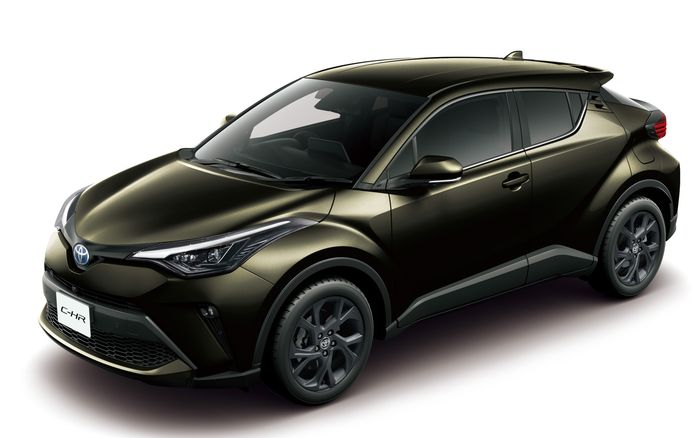
Toyota plans to fully redesign its compact SUV “C-HR” and release it in 2023. However, this second generation model is scheduled to be discontinued in Japan and will be sold exclusively overseas.
ADVERTISEMENT
ADVERTISEMENT
- Production of the second generation “C-HR” will end in Japan
- About the new C-HR full model change
- About the “C-HR Prologue Concept” which is the basis of Toyota’s new C-HR
- Adopts 5th generation hybrid system
- Adopts the latest Toyota Safety Sense
- 2nd generation next generation Toyota Safety Sense feature comparison
- What I think about C-HR
Production of the second generation “C-HR” will end in Japan
The second generation of the compact SUV “C-HR” will not be produced in Japan and will be made exclusively for overseas markets.There are several possible reasons for this, but the biggest one is “Rise,” “Yaris Cross,” and “Corolla Cross.” ” is likely to be selling well.

rise
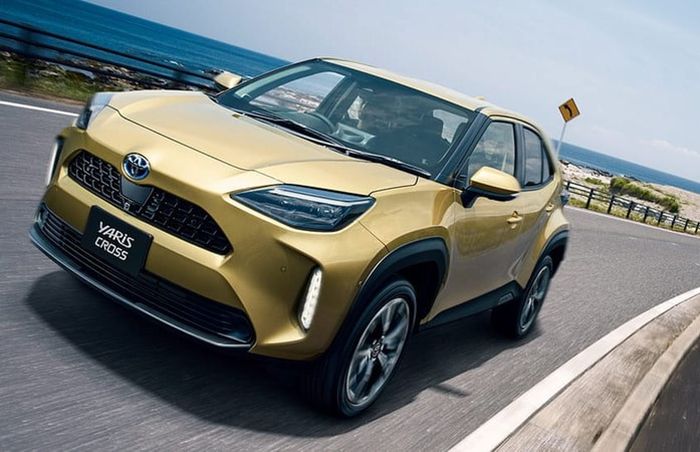
Yaris Cross

corolla cross
Although it is a concept, it has been developed with a focus on driving performance, and has been tested on various roads around the world including the Nurburgring, as well as handling and shock absorber tuning on general roads in Europe. It is “seasoned”. It is a unique crossover SUV that operates like a sports car. Perhaps because of this, it is an SUV that prioritizes sports over visibility, comfort, cargo capacity, minimum ground clearance, etc., so the Japanese market inevitably accepts the Rise, Yaris Cross, and Corolla Cross. .

C-HR
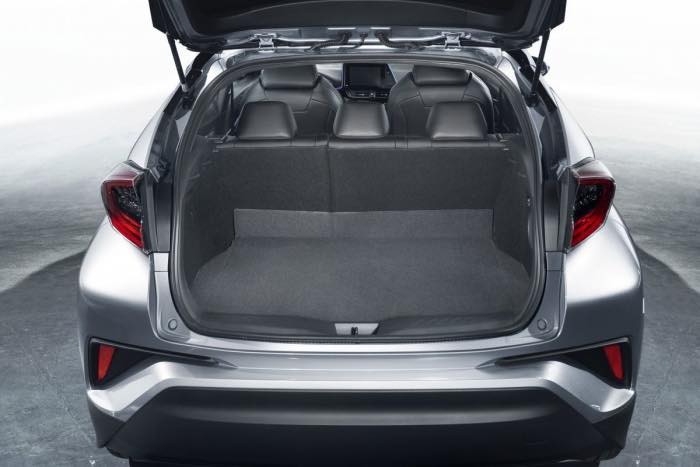
I feel that Nissan’s Juke is very similar to a similar phenomenon.Nissan fully remodeled the second generation Juke, but stopped selling the Japanese model as an overseas model. This is also a new model called “Kix,” which has good visibility and comfort, not just running.
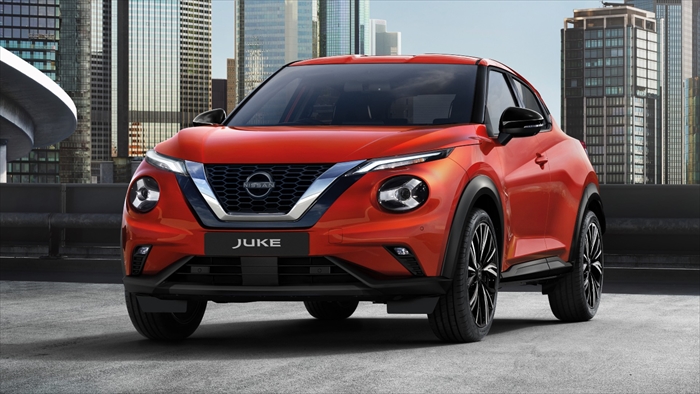
ADVERTISEMENT
ADVERTISEMENT
About the new C-HR full model change
The “C-HR Prologue Concept” was announced in Europe on December 5, 2022 (local time), and the production version of the new 2nd generation “C-HR” scheduled to be announced and released in 2023 was previewed. There is. It features evolved styling with a ‘hammerhead’ style and is available with hybrid and plug-in hybrid powertrains.
Following the first generation, it uses the second generation TNGA (Toyota New Global Architecture) “GA-C platform” . 5th Generation Like the next Prius , the 5th generation hybrid system uses the highly efficient THS II . It uses the next-generation Toyota Safety Sense, which can detect bicycles during the day and pedestrians at night. The exterior design is based on the same concept as a sports model among SUV models.
The “bZ” series released by Toyota on December 14, 2021 included a lineup of the “SMALL SUEV”, a car model that can be said to be the concept of the new “C-HR”. Furthermore, there is a possibility that a BEV (battery EV) that will be installed in the UX ” UX300e ” will be added to the lineup.
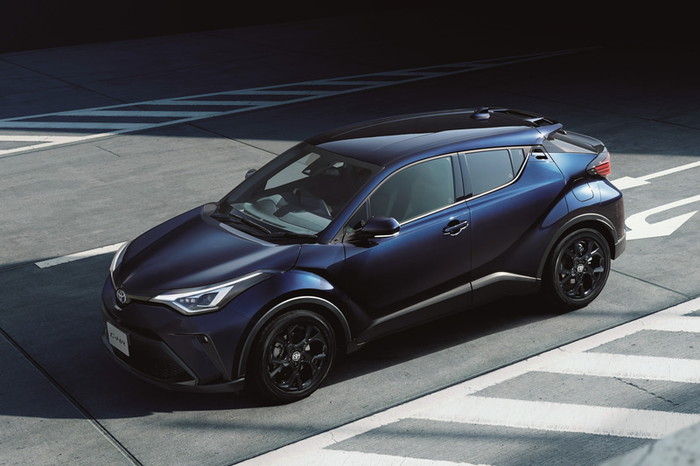
First generation C-HR
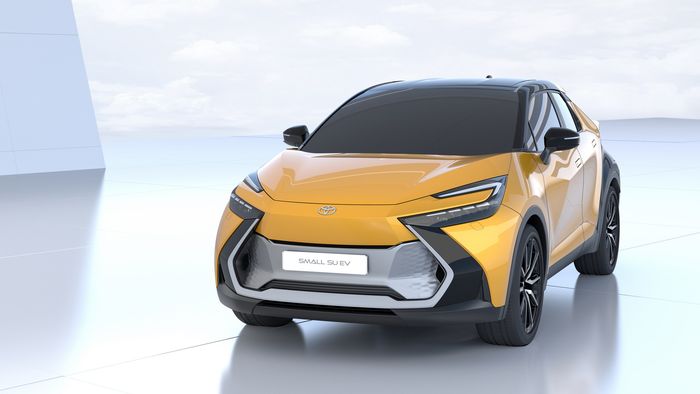
SMALL SUEV
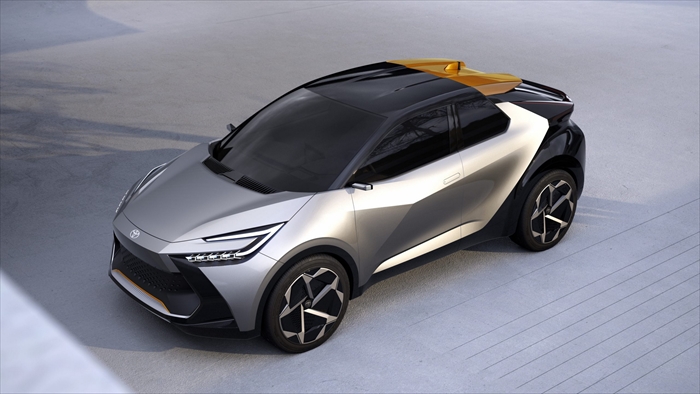
C-HR Prologue Concept
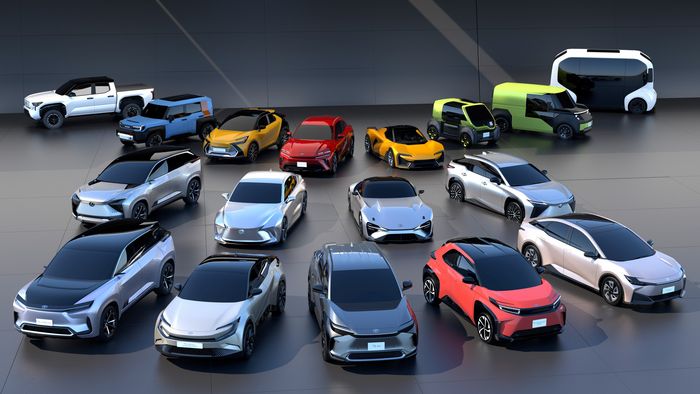
ADVERTISEMENT
ADVERTISEMENT
“Hammerhead” style Large “U-shaped” daylight
It uses a large U-shaped daylight, which is an unprecedented Toyota design, giving it a sense of innovation.

C-HR
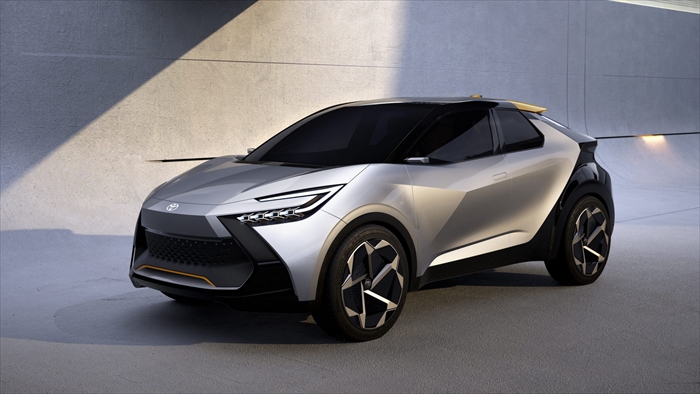
C-HR Prologue
The “hammerhead” style nose, which is inspired by the “hammerhead shark” with full LED headlights, is used on the new Toyota vehicles “Crown” and “Prius”, as well as the new BEV released on December 14, 2021 ( There are several models in the bZ series that feature a similar headlight design , indicating that this is a step forward in Toyota’s design language.
ADVERTISEMENT
ADVERTISEMENT
About the “C-HR Prologue Concept” which is the basis of Toyota’s new C-HR
We are previewing the production version of the new 2nd generation “C-HR”. It decided to follow the same recipe as its successor in terms of swift exterior design and unconventional proportions. Like its predecessor, C-HR Prologue was created by Toyota’s ED2 studio in the south of France. The front bumper has a black element surrounding a large intake that is largely covered to improve aerodynamics. The profile is heavily sculpted with small windows reminiscent of the C-HR. The triangular shape toward the front fenders is new, and the rear quarter panels and C-pillars are more emphasized. Larger wheel diameters, shorter overhangs and a steeper rear windshield make the SUV look sportier and more compact than its predecessor. Toyota’s designers opted for a tri-tone treatment that combines a metallic silver shade on the bodywork with recycled carbon black on the rear section and ‘sulfur’ accents on the bumper and rear spoiler. The production version is expected to retain most of the concept’s exterior design, but some features, such as flush door handles and mirror-swapping cameras, may be swapped out to lower production costs.
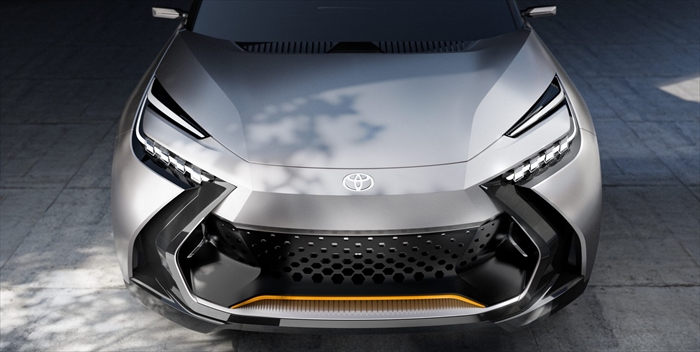
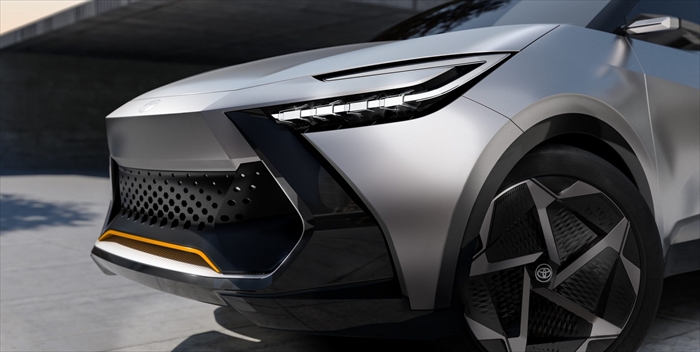
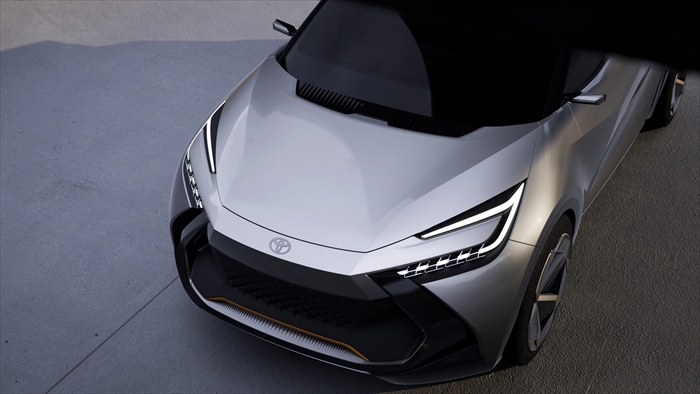

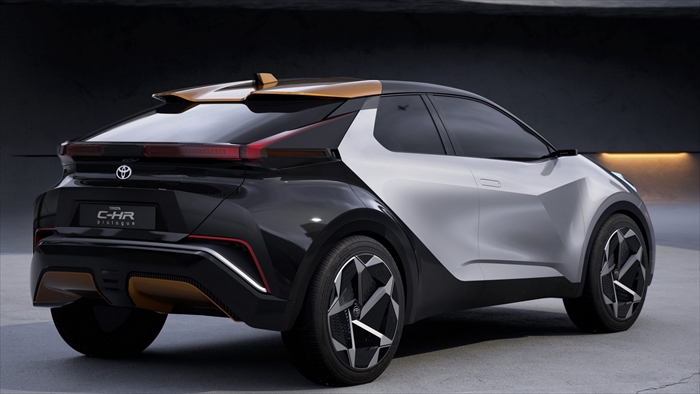
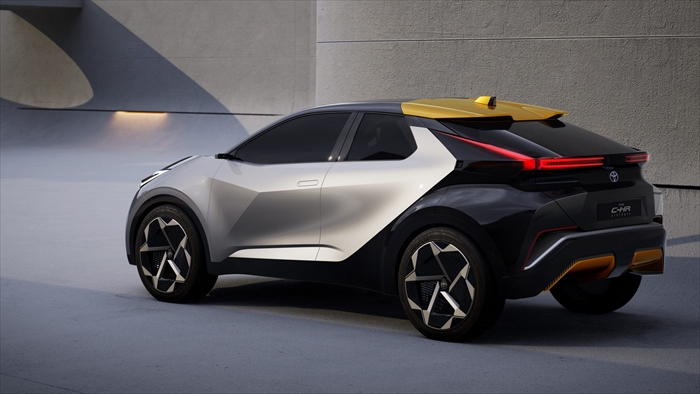
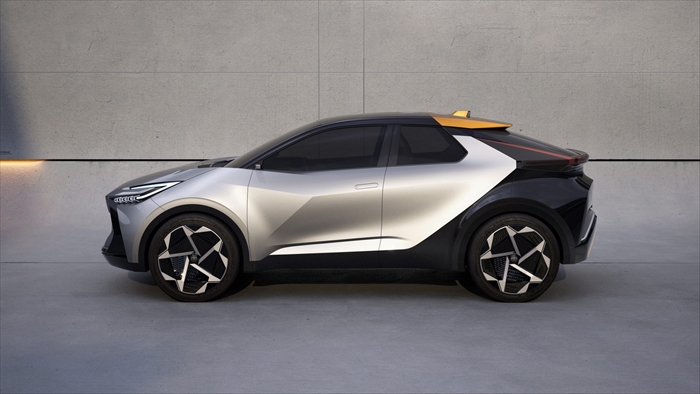
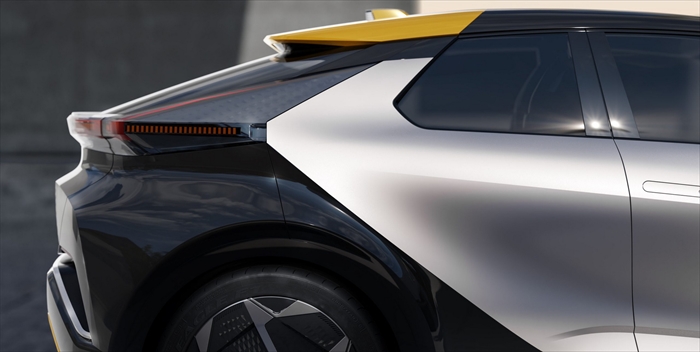
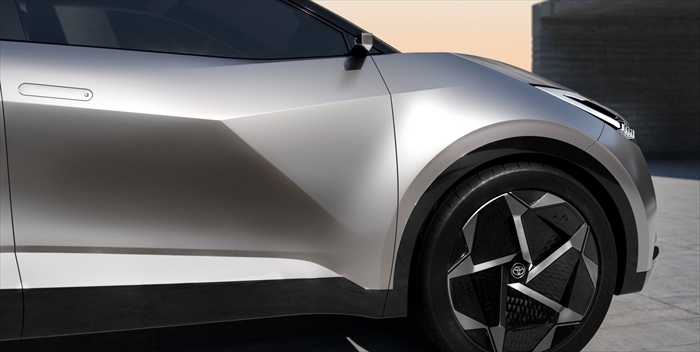
Toyota didn’t show any photos or renderings of the interior, but claims it’s “more spacious and practical” than before. The new C-HR has more technology with a larger screen for the digital cockpit. The concept’s black-tinted windows prevent you from seeing inside.
The new C-HR will be available in hybrid and plug-in hybrid form , the company said in detail regarding the platform and powertrain . This will be Toyota’s third PHEV offering in Europe, following the RAV4 and Prius. It will be based on an evolution of the same TNGA-C architecture as the slightly larger Corolla Cross and new Prius. The self-charging hybrid setup could be sourced from the former, the PHEV from the latter, and the smaller C -HR could have different power and range figures.

ADVERTISEMENT
ADVERTISEMENT
Adopts 5th generation hybrid system
The 5th generation hybrid system employs a series parallel hybrid with a reduction mechanism that combines a 2ZR-FXE inline 4-cylinder DOHC 1.8L engine with a motor . Furthermore, the higher grade model uses a 2.0L straight-4 DOHC “M20A-FXS” + motor to achieve both driving performance and fuel efficiency.
ADVERTISEMENT
ADVERTISEMENT
1.8L straight 4 DOHC + motor model
The straight-4 DOHC 1.8L+ motor (series parallel hybrid with reduction mechanism) model has a significantly stronger front motor and rear motor than the 4th generation Prius , and the front motor has a maximum output of 53kW (72ps) → 70kW ( 95PS), maximum torque 163Nm (16.6kgm) → 185Nm (18.9kgfm), rear motor maximum output 5.3kW (7.2ps) → 30kW (41PS), maximum torque 55Nm (5.6kgm) → 84Nm (8.6kgfm), system output 90kW (122ps) → 103kW (140ps).
ADVERTISEMENT
ADVERTISEMENT
2.0L straight 4 DOHC + motor model
The biggest change this time is the adoption of a straight-4 DOHC 2.0L+ motor (series parallel hybrid with reduction mechanism), which uses a high-output engine and motor, contributing to driving performance and fuel efficiency. Maximum system output is 144kW (190PS), 1.6 times that of the previous model, ensuring power performance befitting the sporty Prius .
Adopts the latest Toyota Safety Sense
It uses the next-generation Toyota Safety Sense, which can detect bicycles during the day and pedestrians at night.
The second generation “Next Generation Toyota Safety Sense” will be installed as standard on all models. “Pre-crash safety,” which can now detect bicycles during the day and pedestrians at night, and “radar cruise control,” which maintains a constant distance from the vehicle in front, assists in steering operations necessary to maintain lane. Equipped with Lane Tracing Assist (LTA). A function to detect bicycle drivers during the day and pedestrians at night has been added to Pre-Crash Safety. Excellent recognition performance and reliability are ensured using millimeter wave radar and cameras. In addition to three types of active safety functions: collision avoidance support type PCS, LDA, and AHB, a pedestrian detection function is added to the PCS. It enables pedestrian collision avoidance support and damage mitigation, and is also equipped with radar cruise control.
Compatible with the latest “collision avoidance support type pre-crash safety”, “detection at intersections”, “low speed acceleration suppression function” and “emergency steering avoidance support function”. Pre-crash safety (PCS) with pedestrian detection function uses millimeter-wave radar and cameras to detect vehicles and pedestrians ahead, and uses warnings, brake assist, and automatic braking to assist in collision avoidance and reduce damage. Automatic braking operates in the speed range of 10 to 80 km/h for pedestrians. For example, if the speed difference between you and the pedestrian is 30 km/h, the automatic brake will decelerate by approximately 30 km/h and assist in collision avoidance. . Additionally, it operates over a wide range of speeds from 10km/h to the maximum speed.For example, if the speed of your own vehicle is 40km/h compared to a stationary vehicle, it can decelerate the vehicle by approximately 40km/h. Furthermore, “ Low speed acceleration suppression function ”, “ Detection of oncoming vehicles and pedestrians when turning right at an intersection ‘ ‘, and “ Emergency steering avoidance support function ” have been added.
- At low speeds, the low speed acceleration suppression function detects pedestrians, cyclists, and vehicles directly in front of the vehicle and suppresses acceleration.
- It can also detect oncoming vehicles when turning right at an intersection, as well as pedestrians crossing from the opposite direction when turning left or right.
- An emergency steering avoidance support function that assists steering in response to the driver’s avoidance steering during an emergency.
Road Sign Assist (RSA) has expanded the range of detection targets, and also reads major traffic signs on the side of the road, such as “Speed Limit,” “Stop,” “No Entry,” and “No Extending,” and displays them on the instrument panel.
A Lane Departure Alert (LDA) camera recognizes white and yellow lines in the driving lane, and if a possibility of lane departure is detected, a buzzer and display alert the driver to avoid collisions caused by lane departure. support.
An automatic high beam (AHB) camera detects the headlights of an oncoming vehicle or the taillights of a vehicle in front, and automatically switches between high and low beams to reduce dazzling to drivers of other vehicles and ensure forward visibility at night. support.
Radar Cruise Control Radar cruise control uses millimeter-wave radar to detect the distance between the vehicle in front and the vehicle in front, and adjusts the speed to match the speed of the vehicle in front within a set vehicle speed, allowing the vehicle to follow the vehicle while maintaining a constant distance. Adopted. Lane changes by the vehicle in front are detected using millimeter wave radar and cameras, achieving smoother acceleration and deceleration control. Aiming for “zero traffic accident casualties”, which is the ultimate wish of a mobility society, Toyota researches and develops various safety equipment and systems based on the “Integrated Safety Concept,” and is committed to “developing safer vehicles and technology.” At the same time, we are strengthening a wide range of initiatives for traffic safety through “participation in improving the traffic environment” and “traffic safety awareness activities for people.”
Lane Tracing Assist (LTA) Lexus Lane Tracing Assist [LTA] installed in the new LS series is adopted for the first time in the next generation Toyota Safety Sense P. When driving on a highway or expressway, turning on the Lane Tracing Assist (LTA) switch when the radar cruise control is activated will provide steering assistance necessary for lane maintenance.
Proactive Driving Assist: Predicts risks depending on the driving situation, such as pedestrians crossing or pedestrians who may jump out, supporting driving operations to avoid getting too close to danger, giving the driver peace of mind. . Furthermore, by supporting deceleration operations in response to preceding vehicles and curves in front, and by reducing the need for frequent pedal depressing operations, the system gently supports the driver in driving situations such as on general roads.
advanced safety
Intelligent Clearance Sonar (Parking Support Brake Stationary) A system that helps reduce damage by mitigating collisions caused by pressing the accelerator incorrectly or pressing too hard. A function has been added to the Clearance Sonar, which uses a display and a buzzer to alert you when you are approaching a stationary object when driving, such as when parking in a garage. Sonar also detects windows such as convenience stores. When driving at low speeds (15 km/h or less), if a stationary object is detected in the direction of travel, the hybrid system output is suppressed and the brakes are automatically applied when the distance further decreases.
Leading vehicle departure notification function If you stop following a vehicle in front while waiting at a traffic light or in traffic jams, and remain there without noticing that the vehicle in front has started, you will be notified with a buzzer and a display.
Emergency brake signal (hazard lamp flashing type) When you apply sudden brakes, the hazard lamp flashes automatically.
Lane Tracing Assist [LTA] system for responding to driver abnormalities. If the driver remains inactive during control, a sound, display, and slow deceleration warning will prompt the driver to take action, and a hazard and horn will alert the driver to abnormalities outside the vehicle. The vehicle decelerates and stops within its own lane while alerting the driver, helping to avoid accidents that cause injury or damage to the vehicle, and reduce accident damage.
Digital interior mirror Images from a camera attached to the rear of the vehicle are displayed on the rearview mirror.
Advanced Park Remote function allows you to back up to the target parking position confirmed on the screen or exit from parallel parking by using the screen display, voice and buzzer to guide you, and by controlling the steering wheel, shift position, accelerator and brakes. assist. Additionally, a dedicated smartphone app is available, allowing you to park remotely from outside the vehicle.
Panoramic View Monitor (360° Monitor) This allows you to see areas that are difficult to reach, such as diagonally behind or directly to the side of the car, allowing you to quickly spot obstacles.
Blind Spot Monitor (BSM) Radar detects vehicles running in adjacent lanes. When the vehicle enters the blind spot area, an LED indicator mounted on the door mirror lights up.
Safe Exit Assist (SEA) When exiting the vehicle, the Blind Spot Monitor [BSM] sensor is used to detect approaching vehicles, including bicycles, from behind. If the system determines that there is a possibility of collision with the opened door or a passenger who has exited the vehicle, an indicator in the door mirror lights up to alert the driver.
Rear Cross Traffic Auto Brake Detects blind spots when reversing and alerts you. If there is a risk of collision, the system automatically applies brake control to help reduce damage caused by collisions with approaching vehicles.
Remote Start (App) A new optional service that allows you to start the engine and start the air conditioner from the MyTOYOTA app.
2nd generation next generation Toyota Safety Sense feature comparison
| System equipment | First generation C-HR |
2nd generation new C-HR |
|
|---|---|---|---|
| Toyota Safety Sense |
Collision avoidance support type pre-crash safety |
◯ Day and night pedestrians, bicycles, and motorcycles |
◯ Day and night pedestrians, bicycles, and motorcycles |
| proactive driving assist |
– | ◯ | |
| Lane departure alert ( with steering control function) |
◯ Steering control white line/yellow line detection wobbling alarm |
◯ Steering control white line/yellow line detection road edge detection sway alarm |
|
| adaptive high beam system |
◯ | ◯ | |
| Radar cruise control (with all vehicle speed tracking function) |
◯ | ◯ | |
| lane tracing assist |
◯ | ◯ | |
| Road sign assist traffic sign reading |
◯ | ◯ | |
| Leading vehicle departure announcement | ◯ | ◯ | |
| preventive safety equipment |
blind spot monitor |
◯ | ◯ |
| intelligent clearance sonar |
◯ | ◯ | |
|
Rear cross traffic |
◯ | ◯ | |
| Advanced Park with remote function |
– | ◯ | |
| Safe Exit Assist (SEA) | – | ◯ | |
| Driver abnormality response system |
– | ◯ | |
| hill start assist control |
◯ | ◯ | |
| panoramic view monitor |
– | ◯ | |
| Comfortable equipment |
Comfortable heated seat + seat ventilation |
◯ | ◯ |
| steering heater | – | ◯ | |
| Digital inner mirror (with front and rear recording function) |
– | ◯ | |
| ITS Connect | ◯ | ◯ | |
| Electric parking brake & hold |
– | ◯ | |
| power seat | ◯ | ◯ | |
| hands free power backdoor |
– | ◯ | |
| heads up display |
◯ | ◯ | |
| digital key | – | ◯ | |
| Naviless | – | – | |
| toyota display audio |
◯ | ◯ | |
| In-vehicle communication device (DCM) | ◯ | ◯ | |
What I think about C-HR
“C-HR” is a compact SUV that Toyota has been selling since December 14, 2016. It is the second model to adopt the common platform TNGA (Toyota New Global Architecture), following the Prius. As a Toyota car at the time, it was challenging the new genre of compact SUV. Following on from the new 5th generation Prius, this second generation model is equipped with excellent equipment for this class, including the latest hybrid system and safety equipment. It will be a model that combines not only fuel efficiency but also comfort. However, times have changed, and while the only models that used Toyota’s “hybrid system” were the “Prius” and “C-HR,” many “Toyota vehicles” now use the same “hybrid system.” It is also true that fewer people are choosing the C-HR because of this.
C-HR
